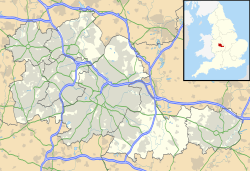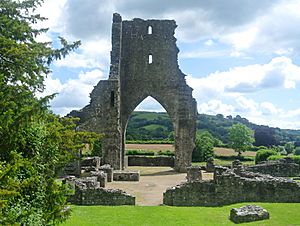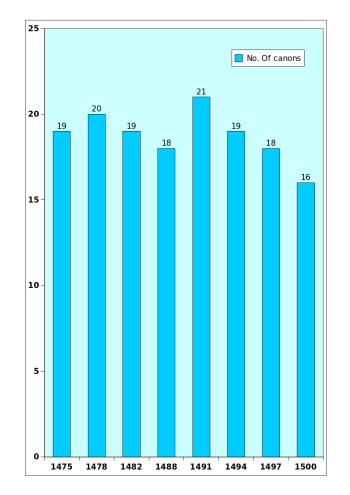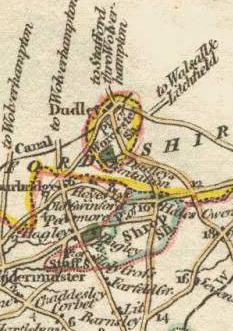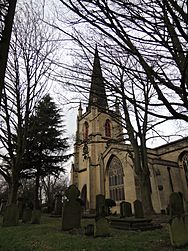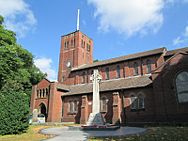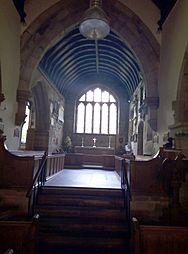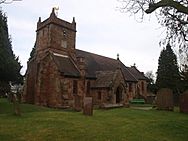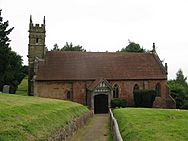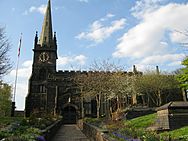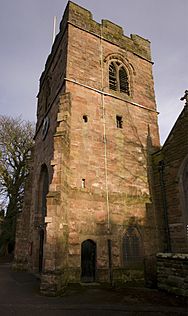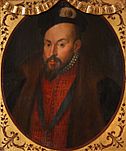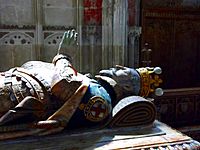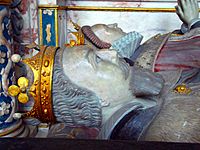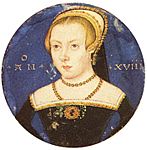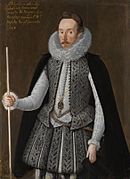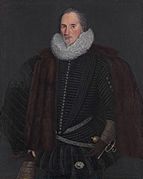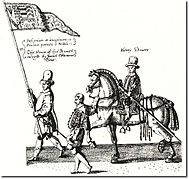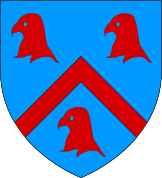Halesowen Abbey facts for kids

The ruins of Halesowen Abbey.
|
|
| Monastery information | |
|---|---|
| Other names | Abbey of Hales |
| Order | Premonstratensian |
| Established | 1218 |
| Disestablished | 9 June 1538 |
| Mother house | Welbeck Abbey |
| Dedicated to | The Blessed Virgin Mary for the Feast of the Assumption and St John the Evangelist. |
| Diocese | Diocese of Worcester |
| Controlled churches | Halesowen Walsall Wednesbury Harborne Clent Rowley Regis Cradley Warley Wigorn Lutley |
| People | |
| Founder(s) | Peter des Roches, Bishop of Winchester |
| Site | |
| Location | Halesowen, West Midlands, B62 8RJ |
| Coordinates | 52°26′37″N 2°02′12″W / 52.4436°N 2.0368°W |
| Visible remains | Parts of north wall of the presbytery, south transept and south aisle, south range of cloister. Vestiges of water control features, including mills. |
| Official name: Halesowen Abbey and associated water control features | |
| Designated: | 8 February 1915 |
| Reference #: | 1009770 |
|
Listed Building – Grade I
|
|
| Official name: St Mary's Abbey Ruins, Manor Farm | |
| Designated: | 10 January 1950 |
| Reference #: | 1063731 |
| Public access | Visible from nearby footpath. No direct access. |
Halesowen Abbey was a Premonstratensian abbey located in Halesowen, England. Today, only its ruins remain. It was started by Peter des Roches, who was the Bishop of Winchester, with land given by King John. The abbey officially opened in 1218. Over time, it became the "mother house" to two other abbeys and a smaller priory. It also gained many estates (large areas of land) nearby and several churches. The abbey was quite successful and managed to avoid being shut down during the first wave of monastery closures. However, it was eventually dissolved in 1538.
Contents
Starting the Abbey: Early Years
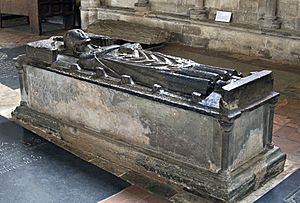
Halesowen Abbey began when King John gave the land of Halesowen to Peter des Roches, the Bishop of Winchester, in 1214. The king wanted Peter to build a religious house there. The next year, King John confirmed that the land was for the "canons of the Premonstratensian order" at Hales.
However, the official founding date for Halesowen Abbey is 1218. This was a few years after the "White Canons" (as they were called because of their white clothes) had already started living there. This delay was common for Premonstratensian houses. An abbey needed at least 13 canons to be fully set up, and often wasn't considered complete until its church was ready for special ceremonies. Also, many abbeys were dedicated to the Blessed Virgin Mary for the Feast of the Assumption (August 15th), so they would wait until that date to officially open.
In 1218, canons from Welbeck Abbey in Nottinghamshire came to Halesowen. This likely helped bring the number of canons up to what was needed. Peter des Roches also received money from the king to help with the building costs. It's thought that Halesowen Abbey was officially opened on the Feast of the Assumption in 1218, during the early reign of Henry III.
Building work continued for several years. In 1223, the bishop received wood from the royal Kinver Forest to help with the "refurbishment of his church of Hales." This suggests that major construction, possibly including roof work, was still happening.
In 1227, King Henry III confirmed the abbey's status and its ownership of the Halesowen land. He also made it clear that the abbey was answerable to the Bishop of Winchester as its patron.
Abbey's "Daughter Houses"
Titchfield Abbey
Peter des Roches later founded another Premonstratensian abbey called Titchfield Abbey in Hampshire. Canons from Halesowen went to start this new abbey. While some sources say it was founded in 1222, the abbey itself stated its founding date as 1231, which matches its official charter. The abbot of Halesowen was the "father abbot" for Titchfield.
Talley Abbey
Talley Abbey in Wales was older than Halesowen Abbey, founded in the late 1100s. It suffered a lot from wars. In 1291, the head of the Premonstratensian order asked King Edward I to help the abbots of Halesowen and Newsham Abbey visit Talley. This helped the king bring Welsh religious houses under English control.
For a long time, it was unclear whether Halesowen or Welbeck Abbey was the "father abbot" for Talley. Abbots from Halesowen were involved in most of the visits to Talley. In 1414, the abbot of Welbeck officially gave up his claim to be Talley's father abbot, passing the role to Halesowen. By 1478, it was confirmed that the abbot of Halesowen was indeed the father abbot of Talley.
Dodford Priory
Halesowen Abbey took over the Augustine Dodford Priory in 1464. At this time, Dodford Priory had only one canon left and was in financial trouble. The king allowed Halesowen to absorb it because of its financial difficulties. Halesowen Abbey then treated Dodford as a small outpost and managed its resources, which greatly increased its income. By 1500, Dodford was simply seen as one of Halesowen's estates.
Abbots and Abbey Life
Abbots and the Order
| Prémontré Abbey 1120 |
|||||||||||||||||||||||||||||||||||||||||||||||||||||||||||||||||||||||||||||||||||||
| Licques Abbey 1132 |
St. Radegund's or Bradsole Abbey 1192—3 |
Bayham Abbey 1200 |
|||||||||||||||||||||||||||||||||||||||||||||||||||||||||||||||||||||||||||||||||||
| Newsham Abbey 1148 |
|||||||||||||||||||||||||||||||||||||||||||||||||||||||||||||||||||||||||||||||||||||
| Broadholme Priory By 1154 |
|||||||||||||||||||||||||||||||||||||||||||||||||||||||||||||||||||||||||||||||||||||
| Alnwick Abbey 1147 |
St Agatha's or Easby Abbey 1152 |
Welbeck Abbey 1153 |
Barlings Abbey 1154 |
Sulby Abbey 1155 |
Croxton Abbey 1162 |
Beeleigh Abbey 1180 |
Tupholme Abbey By 1190 |
Newbo Abbey 1198 |
Dale Abbey 1204 |
Coverham Abbey 1212 |
|||||||||||||||||||||||||||||||||||||||||||||||||||||||||||||||||||||||||||
| Egglestone Abbey c. 1200 |
Lavendon Abbey By 1180 |
Hornby Priory c. 1200 |
Blanchland Abbey Before 1190 |
Cockersand Abbey c. 1190 |
|||||||||||||||||||||||||||||||||||||||||||||||||||||||||||||||||||||||||||||||||
| Langley Abbey 1195 |
Guyzance Priory c. 1150 |
Shap Abbey c. 1200 |
|||||||||||||||||||||||||||||||||||||||||||||||||||||||||||||||||||||||||||||||||||
| Wendling Abbey c. 1265 |
Hagnaby Abbey 1175 |
Leiston Abbey 1183 |
Beauchief Abbey 1183 |
West Dereham Abbey 1188 |
Torre Abbey 1196 |
Dureford Abbey By 1217 |
Halesowen Abbey 1218 |
||||||||||||||||||||||||||||||||||||||||||||||||||||||||||||||||||||||||||||||
| Langdon Abbey 1212 |
Titchfield Abbey 1231 |
Talley Abbey By 1197 |
Dodford Priory probably 1180s |
||||||||||||||||||||||||||||||||||||||||||||||||||||||||||||||||||||||||||||||||||
|}
The abbots of Halesowen were important leaders within the Premonstratensian order. Since Halesowen was a "daughter house" of Welbeck Abbey, the abbot of Welbeck would visit Halesowen to check on things. In turn, the abbot of Halesowen was the "father abbot" for Titchfield, and later for Talley and Dodford. This meant he had to visit them every year and help with the election of their leaders.
Abbots also worked together in regional groups called circaria. Halesowen was part of the English Middle Circaria, which covered a wide area. This system helped abbeys support each other. For example, in 1311, when English abbeys were having problems with the head of the order, they used the circaria system to raise money for an appeal.
Sometimes, the abbot of Halesowen would attend larger meetings of the order in Britain and Ireland, called the Provincial Chapter. They might even travel to the General Chapter in Prémontré, France. In 1327, the abbot of Halesowen needed special permission to travel to France, showing how important these meetings were.
Choosing a New Abbot
Premonstratensian houses elected their own abbots. The goal was to choose someone everyone agreed on. The earliest election at Halesowen that we know about was in 1322, when the canons couldn't agree. The abbot of Welbeck, the "father abbot," had to step in and choose Thomas de Lech, who was then accepted. After a special song, Thomas was formally installed in the abbey church.
In 1486, the canons successfully used a method called "compromission." They chose a small group to make the decision, and this group quickly elected Thomas Bridge as the new abbot. The visiting abbots approved the choice, and Thomas was installed.
Another quick election happened in 1505. After a special Mass, the canons chose Edmund Green. Once everyone agreed on his good reputation, the visiting abbots approved and confirmed his election.
Challenges to an Abbot
In 1311, Abbot Walter de la Flagge faced a major challenge. The head of the order asked other abbots to visit Halesowen because of problems. They found the abbot and some canons were not following the rules. However, the accused used a royal order to try and stop the visitors. The visitors were even kicked out of the abbey! They later announced that the abbot and others were excommunicated (removed from the Church). It's not clear exactly what happened next, but the next abbot was chosen in 1314.
Canons of Halesowen
Numbers of Canons
The number of religious people in England dropped a lot after the Black Death in the 1300s. In 1381, Halesowen Abbey had only 11 canons. Records from the late 1400s show the number of canons at Halesowen, as seen in the chart.
Roles and Jobs
The Premonstratensian canons at Halesowen were not just monks; they had many different jobs both inside and outside the abbey. They would start as novices, learning about the community, and then become full members. They also progressed through different levels of religious service, like becoming a priest.
The records show the different jobs canons held. For example, Richard Edgbaston was the prior (second in command) and also the cellarer, meaning he was in charge of the abbey's food and drink. He was also the sacristan, looking after the church's special items. Other canons were vicars, serving as priests in churches controlled by the abbey, like Halesowen, Walsall, and Clent. Some canons had special skills, like Richard Harborne, who was a "metrista" (skilled in verse).
What They Ate
The rules for canons suggested they should eat simply and fast often. This meant they usually ate meat-free meals most days of the year. In 1478, the canons complained about the abbey's bread, saying it was "inadequate" and "not made of wheat." The abbot ordered that the bread be improved. Records from ten years later show the abbey used a lot of wheat for bread and many animals for meat, suggesting the canons were well-fed, especially when considering the many guests the abbey hosted.
Abbey Lands and Income
Halesowen Manor: The Abbey's Home Base
The land of Halesowen was given to the abbey at its founding and remained its most important economic and political center. In 1086, the Domesday Book showed Halesowen as a large settlement. It was originally in Worcestershire but was later moved to Shropshire. This meant that Halesowen Abbey was in a part of Shropshire surrounded by Staffordshire and Worcestershire. This could be confusing for people living there, especially since the abbey was in the Anglican Diocese of Worcester, but the abbey itself was independent of the local bishop.
The abbey also received permission to create a "borough" (a town with special rights) at Halesowen. This allowed people to rent plots of land and enjoy certain freedoms. However, the town didn't become truly independent, and its courts were often the same as the abbey's manorial courts.
Problems with Tenants
The abbots of Halesowen often had disagreements with their tenants (people who lived and worked on the abbey's land). The tenants felt that the abbey's power over them was too great. For example, in 1243, tenants agreed to pay certain fees and perform labor, but they complained that they couldn't challenge the abbot's decisions in the king's courts.
The abbots had a lot of control over their tenants' lives. In 1274, two men were told to marry widows chosen by the abbey's cellarer. Another man, Roger Ketel, was fined for not giving the abbot a "heriot" (a payment due when a tenant died). Ketel often challenged the abbey's authority. In 1280, he and others refused to use the abbey's mills, which were new and unpopular. Ketel died shortly after being put in the stocks by abbey officials, possibly due to his resistance.
In 1278, the tenants even questioned the abbot's right to rule over them, claiming their land was royal property. King Edward I investigated, but the abbot proved his right to the land. Ketel was fined a large sum for his part in this challenge.
Tenants also caused trouble by fishing in the abbey's streams and pools without permission. In 1293, children from Romsley even knocked down the abbey's gallows, showing their defiance.
Tensions eased somewhat in 1327 when the abbot agreed to let tenants pay a fixed rent instead of doing labor. By the 1400s, after the Black Death made labor more valuable, major conflicts seemed to end, likely because conditions for workers improved.
Small Land Gains
Throughout the 1200s, Halesowen Abbey slowly gained more land. They had good relationships with the lords of nearby Frankley manor, who gave them land and rents. In Halesowen itself, the abbey gained more land and permission to build mills.
The Lenches
In 1227, the abbey received 40 acres of land at Ab Lench. William Marshal, 2nd Earl of Pembroke, a powerful noble, also gave the abbey rights to common pasture there. However, the abbey soon faced conflicts with local landowners who accused them of building on common land.
The abbey also received other small gifts of land in the Lenches area, close to the Worcestershire/Warwickshire border.
Harborne and Smethwick
The manor of Harborne and Smethwick was given to Halesowen Abbey by Margaret de Redvers. This grant also included the right to appoint the priest for the church there, which caused many problems later. The abbey gained full control of these manors by 1284.
During the reign of King Edward I, the abbots sold small plots of land in Harborne and Smethwick to people who wanted to develop them. These plots were often in uncultivated areas.
Rowley
In 1331, John de Hampton gave the manor of Rowley to Halesowen Abbey. In return, a canon would pray daily for his family. King Edward III confirmed this gift but required the abbey to pay an annual rent for it. The king could then give this rent to others, like Alice Plomton, a lady-in-waiting to his sister. Later, in 1486, King Henry VIII gave this rent to his wife, Elizabeth of York.
Warley
The manor of Warley was given to Halesowen Abbey in 1337/8 by Joan Botetourt. She wanted the abbey to use the income to pay for three canons to say daily Mass for the royal family and her own family. She also asked for money to be given to the poor and for special candles to be burned.
To make sure the gift was secure, Joan had to get approval from other powerful people, including the lords of Dudley. The abbey then leased the manor back to Richard Fokerham, who was the original owner, for his lifetime for a very small payment. This was a common way to handle complicated land deals and debts in medieval times.
Granges and Leases
Like most religious houses, Halesowen Abbey managed its own lands through a network of "granges." These were like farm centers, used for storage and administration. Early on, the abbey had problems when it tried to build a grange on common land. Records show that granges were used to store grain for tenants and for the abbey's own use.
The 1300s brought economic challenges, like the Great Famine of 1315–1317 and the Black Death. These events made labor more valuable and land less so. Halesowen Abbey, like other landowners, started leasing out more of its land to farmers. They also sold small plots of land. Over time, this changed how land was owned and worked, moving from a system of serfs to more independent farmers.
By the 1400s, the abbey started leasing out entire granges for many years. For example, in 1415, a group of people leased five granges for sixty years. This might have been a way for the abbey to reduce its tax payments or avoid "voluntary" loans to the king during wartime. By the abbey's last century, leasing out major assets and even crops to wealthy individuals became common. In 1535, records show that most of the abbey's income came from rents and leases.
Churches Controlled by the Abbey
In 1478, Halesowen Abbey stated it controlled three churches: Halesowen, Walsall, and Clent. However, the history behind these claims was often complicated by disputes and changing ownership.
Halesowen Church
The abbey had the right to appoint the priest for Halesowen church because it came with the manor. This right, called an "advowson," had always belonged to the lord of the manor. However, the abbey didn't get the church's tithes (a portion of income) at first. To gain full control, the abbey needed to "appropriate" the church, meaning they would install a vicar and use the tithes to support him. This happened in 1270.
The Bishop of Worcester had authority over Halesowen church, even though he didn't control the abbey itself. The abbey was expected to make certain payments and give gifts to the bishop when a new abbot was chosen.
Frankley church was a smaller chapel connected to Halesowen church. The abbey had to fight for control of its advowson until 1297.
Walsall and Wednesbury Churches
Walsall church and its chapels were given to Halesowen Abbey by William Ruff, the lord of Walsall manor. This happened around 1220. However, this gift was very complicated because the church had previously been given to the Bishops of Coventry by King John.
There were many legal battles over who truly owned the right to appoint the priest at Walsall. Even after royal and papal confirmations that Halesowen Abbey owned the advowson, King Henry III still tried to appoint his own priests. Eventually, the abbots of Halesowen were able to appoint their own canons as vicars of Walsall, starting around 1309.
The church of Wednesbury was also connected to Walsall. In 1293, the king's officials challenged the abbey's claim that Wednesbury was part of Walsall church. The jury decided Wednesbury was a separate church. The abbey paid a large sum to regain the right to appoint its priest and to appropriate it.
Harborne Church: A Short-Term Gain
Halesowen Abbey was given the right to appoint the priest for St Peter's Church, Harborne by Margaret de Redvers. However, this gift was complicated because the land had been seized by the king during a war.
In 1238, the abbot of Halesowen was involved in a legal case over Harborne church. The case went against the abbey, and they had to give up their claim to the advowson. Although the abbey tried to reclaim the right later, they eventually gave up all claims to Harborne church in 1278.
Clent Church
In 1340, King Edward III allowed John Botetourte to give the advowson of Clent church and its chapels to Halesowen Abbey. John made this gift for the well-being of his own soul and his family. The abbey paid a small fee to have this gift confirmed by King Richard II in 1393.
The abbey quickly took control of Clent church in 1343. They said they needed the income because Halesowen was on a main road and they had lost money from a fire and a decline in visitors to one of their holy relics.
In 1467, King Edward IV allowed the abbey to acquire more property to support a chaplain and maintain the chapel of St Kenelm. This chapel was partly in Clent and partly in Romsley. The king wanted this chapel to be a place of prayer for himself and his wife, Elizabeth Woodville.
The End of the Abbey
Abbey Closure
In 1535, a survey found that Halesowen Abbey had a net income of about £280. This was one of the highest incomes among Premonstratensian houses in England. This meant it was above the £200 limit that would have caused it to be shut down in 1536. However, Thomas Cromwell, a powerful minister, still took money from the abbey.
The abbey was officially surrendered by its last abbot, William Taylor, on June 9, 1538. It was then handed over to Thomas Legh, who sent the surrender papers to Cromwell.
Around that time, the abbey's movable property, valuable items, lead, bells, and buildings were sold off. Some items were bought for Halesowen church, including an organ and a cross.
Selling Off the Lands
The abbey's lands were given to Sir John Dudley on September 1, 1538, for a very low rent. Dudley then gave the abbey's main house (the ruins) to his servant. Dudley became a very powerful man under King Edward VI, but his lands were taken away when Queen Mary I came to power. After this, the abbey's estates were sold off and divided among many different owners.
Halesowen Manor
When John Dudley was executed in 1553, his wife, Jane, managed to keep Halesowen manor. She left it to her sons, who later sold it to Robert Dudley. Robert and his wife, Amy, then sold the manor in 1558 to George Tuckey and Thomas Blount.
On November 3, 1558, the manor was transferred to Sir John Lyttelton. The Lyttelton family became the main landowners in Halesowen for over 300 years. Sir John's daughter-in-law, Meriel, worked hard to rebuild the family's wealth after some financial troubles. She even had the weekly market and annual fair in Halesowen reinstated in 1608, bringing back some of the privileges the abbey once held.
Other Estates
After John Dudley's fall, Queen Mary I gave some of the confiscated estates, including Harborne, Rowley, and Smethwick, to Edward Sutton, 4th Baron Dudley. Later, in 1604, Edward Sutton sold Harborne and Smethwick to Charles Cornwallis. Cornwallis, a diplomat, died there in 1629. The manor was later sold to Thomas Foley in 1661 and continued to be sold over time.
John Dudley also sold the former abbey lands in Church Lench to William Scudamore. The Scudamore family owned these lands for many years, becoming important figures in court and the arts. However, the manor was eventually sold to William Keyt in 1627 and later dispersed through more sales.
Present Day
The ruins of Halesowen Abbey are now a scheduled monument and a Grade I listed building. English Heritage manages the abbey, but the land around it is privately owned. This means you can only see the ruins from a distance, as there is no direct public access.


